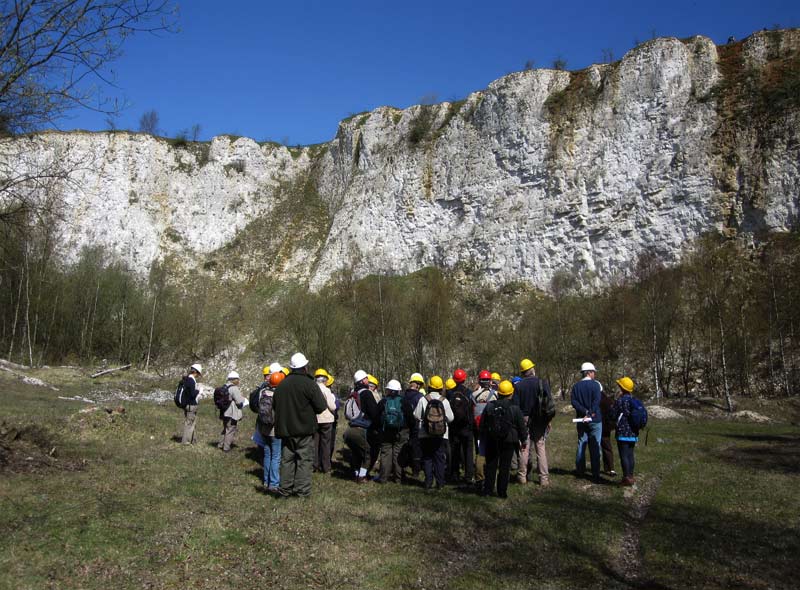Diana Clements, London Geodiversity Partnership

Riddlesdown Chalk Pit
It’s not always possible, especially in an urban environment, to see the geology beneath our feet. Only in temporary excavations and in the greener parts of Greater London can geological sites be clearly seen. Unfortunately, many of these are disappearing fast under bricks and mortar.
The London Geodiversity Partnership (LGP) aims to protect the best of Greater London’s geological sites by identifying where geology can be seen or at least inferred, and by working with local planning authorities to provide official recognition of a site’s importance through their designation as regionally or locally important geological sites (RIGS and LIGS).
The process of drafting, consulting on, and designating geological sites in local development plans takes a long time but, for those with planning interests, GiGL can provide an early view of sites deemed worthy of protection through the use of their geodiversity dataset, which they manage on the LGP’s behalf.
The partnership is already enjoying some success. For example, we are working with developers in Bexley to conserve a rare exposure of brickearth; a wind-blown fine dust or ‘rock-flour’, deposited as glaciers retreated during the most recent ice age. The worked out brick-making site is now formally protected within a large new development and an interpretation panel will be erected to explain the geology.
Geology forms the bedrock, literally, of the world and is particularly important from an educational point of view. Non-renewable energy and raw materials are provided by the geology beneath our feet. Geology influences where we situate buildings, the layout of our city’s infrastructure, filters our drinking water and affects the flow of flood waters. The LGP is highlighting the importance of RIGS and LIGS to local communities through conservation and interpretation; engaging teachers, erecting interpretation boards, holding events and creating geotrails.
Our latest venture is to make the information on RIGS and LIGS; currently only published in the London Plan implementation report “London’s Foundations” and within the GiGL dataset; available in a user-friendly guide to London’s geological sites. This will soon be available on the LGP website. The guide will describe each site’s geology and its historical significance. Additional “Sites of Geological Interest” (SGIs) will be added to tell of historic geological finds or locations that have long since disappeared under buildings.
One such site is in Ilford, where a magnificent woolly mammoth, now on display in the Natural History Museum, was excavated from the brickearth 150 years ago. A plaque at the Ilford Methodist Church commemorates the find and this year Ilford will be celebrating the milestone anniversary of its discovery by hosting a festival.
Many of London’s geological sites were former quarries. Their geology had sometimes been described and pictured in publications when the quarries were operational. Now, many are badly overgrown. However, with a little conservation, the chalk, sands, clays or gravels could be revealed for use in both research and education.
One of the most spectacular sites is the large disused chalk quarry at Riddlesdown in Croydon. Nearly 50m of chalk are exposed making it an invaluable asset for researchers and engineers studying the nature of the chalk beneath London. The site is conserved by the City of London Corporation with the help of local volunteers and a flock of sheep. Steps have been created up a spoil heap to aid close examination of the chalk face. It is well worth looking out for a guided tour with the rangers.
The new LGP guide covers all these sites and more. It has an interactive map so that the public can easily find places of interest in their neighbourhood. Many of these are located in public spaces, particularly on the periphery of London.
Diana Clements became interested in geology as an adult when she began tumble-polishing pebbles collected on the beach. She was curious to understand why they all behaved in a different way, some disappearing completely. In search of the answer to this and other questions, she completed a degree in geology with the Open University. Following her degree, Diana got a job as an explainer in the Natural History Museum, London. During lunch-breaks, she researched the geology of her neighbourhood which eventually resulted in an exhibition “Beneath our feet: the geology of Islington”. The geology of London became her passion and she went on to compile a Geologists’ Association guide of that name. With her knowledge of London sites she was invited to join the London Geodiversity Partnership near its beginning and was able to feed in additional locations to the first edition of London’s foundations in 2009.

Hello Diana good to see that you are still active and publishing on local geology. It must be over 15 years since we last met on London OUGS field trips. I was interested in the trilobites traces from Penha Garcia which you figures in a field report, and was hoping I could use two of them in a new book I am (very slowly) writing – Geology: an illustrated introduction. If this mail gets to you please contact me on my email.
Best wishes
Gareth